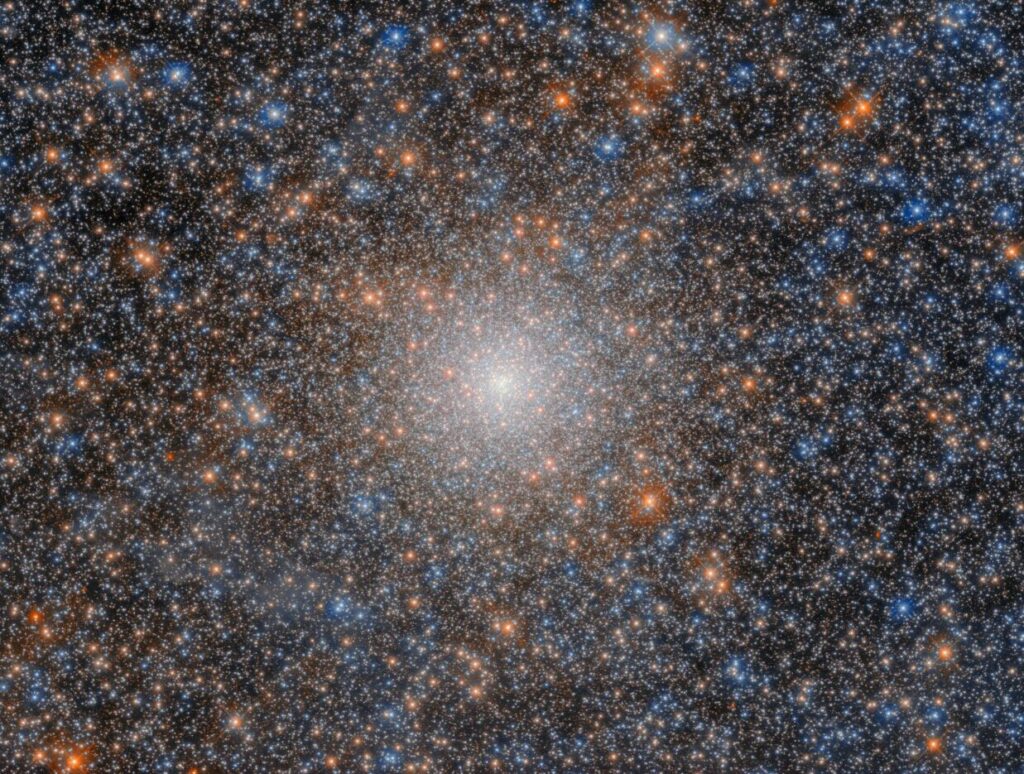|
Getting your Trinity Audio player ready...
|
Gazing into the depths of the Large Magellanic Cloud (LMC), our Milky Way’s closest satellite galaxy, astronomers have stumbled upon a fascinating anomaly – a globular cluster named NGC 2005. Globular clusters are densely packed spheres of stars, often containing hundreds of thousands or even millions of stars, all tightly bound by gravity. These ancient stellar congregations act like cosmic fossils, holding secrets about the formation and evolution of galaxies.
Unveiling the Secrets of Globular Clusters
Imagine studying fossils on Earth to understand the creatures that roamed millions of years ago. Studying globular clusters serves a similar purpose. By analyzing the properties of the stars within them, astronomers can glean insights into the conditions present during a galaxy’s early stages.
One of the key aspects scientists examine is the chemical composition of the stars. This composition, primarily determined by the elements heavier than hydrogen and helium (often referred to as “metals” in astronomy), reflects the materials available at the time the stars formed.
Current theories of galaxy evolution propose that the grand, majestic galaxies we see today, including our Milky Way, were once smaller entities that merged over billions of years. These mergers would have significantly impacted the chemical composition of the newly formed galaxy.
NGC 2005: A Chemical Outlier
NGC 2005 throws a wrench into the seemingly uniform tapestry of the LMC. This globular cluster, nestled about 750 light-years from the LMC’s heart, stands out because the chemical makeup of its stars is demonstrably different from the stars surrounding it.
This peculiarity holds the key to unlocking a hidden chapter in the LMC’s history. The distinct chemical signature of NGC 2005’s stars strongly suggests that the LMC was once involved in a galactic merger with another galaxy. This long-lost partner has likely been completely absorbed or dispersed by the LMC, leaving NGC 2005 as the sole remaining witness to this ancient cosmic event.
Hubble Captures a Galactic Fossil
The stunning image of NGC 2005, captured by the Hubble Space Telescope, showcases the globular cluster in all its glory. The densely packed nature of the cluster is evident, with countless stars shimmering against the backdrop of the vast cosmos.
While the image itself doesn’t reveal the chemical composition of the stars, it serves as a powerful reminder of the vast timescales involved in galactic evolution. The stars within NGC 2005 are likely billions of years old, harboring stories from a time when the LMC was still undergoing its formative stages.
Beyond Hubble: Unveiling the Mysteries of NGC 2005
Hubble’s observations provided the initial clue about NGC 2005’s peculiarity. However, astronomers are delving deeper to understand the full story. Spectroscopic analysis, a technique that breaks down the light from stars into its constituent wavelengths, allows scientists to determine the precise chemical composition of the stars within NGC 2005.
By comparing the chemical signatures of the stars in NGC 2005 with those in other parts of the LMC and even our Milky Way, researchers can build a more comprehensive picture of the merger event. They can estimate the size and composition of the mystery galaxy that collided with the LMC, and potentially place this event within the broader timeline of the LMC’s evolution.
The Significance of NGC 2005: A Window into Galactic Collisions
The discovery of NGC 2005 adds another crucial piece to the puzzle of galaxy evolution. It provides strong observational evidence to support the theory of galactic mergers, demonstrating its impact on the chemical composition of stars.
Future studies of NGC 2005, alongside other similar discoveries, can help astronomers refine their understanding of how these mergers unfold, the timescales involved, and the lasting impact they have on the resulting galaxies. As we continue to explore the cosmos, these galactic fossils will undoubtedly continue to unveil the dramatic and dynamic history of our universe.
